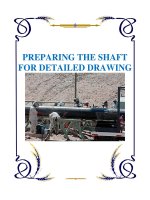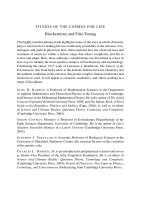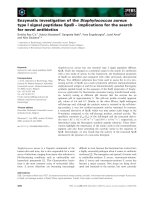the search for antarctic dinosaurs
Bạn đang xem bản rút gọn của tài liệu. Xem và tải ngay bản đầy đủ của tài liệu tại đây (6.92 MB, 50 trang )
J Millbrook Press/Minneapolis
Note to readers: Say the word Cryolophosaurus ellioti like cry-oh-LOHF-oh-SOHR-uhs
eh-lee-AH-tee.
The author and artist would like to thank Dr. William Hammer and Susan Kornreich
Wolf of the Fryxell Geology Museum, Augustana College, for patiently answering our
many questions, reading the manuscript for accuracy, and providing an invaluable as-
sortment of visual reference that helped bring this book to life.
Text copyright © 2008 by Sally M. Walker
Illustrations copyright © 2008 by Lerner Publishing Group, Inc.
All rights reserved. International copyright secured. No part of this book may be
reproduced, stored in a retrieval system, or transmitted in any form or by any
means—electronic, mechanical, photocopying, recording, or otherwise—without the
prior written permission of Lerner Publishing Group, Inc., except for the inclusion of
brief quotations in an acknowledged review.
Millbrook Press, Inc.
A division of Lerner Publishing Group, Inc.
241 First Avenue North
Minneapolis, MN 55401 U.S.A.
Website address: www.lernerbooks.com
Library of Congress Cataloging-in-Publication Data
Walker, Sally M.
The search for Antarctic dinosaurs / by Sally M. Walker ; illustrations by John
Bindon.
p. cm. — (On my own science)
Includes bibliographical references.
ISBN-13: 978–0–8225–6749–3 (lib. bdg. : alk. paper)
1. Dinosaurs—Antarctica—Juvenile literature. 2. Fossils—Antarctica—Juvenile
literature. I. Bindon, John, ill. II. Title.
QE861.5.W34 2008
567.909989—dc22 2006028779
Manufactured in the United States of America
1 2 3 4 5 6 – JR – 13 12 11 10 09 08
eISBN-13: 978-1-58013-687-7
To Jameson Rush—There are a gazillion fossils
waiting to be discovered. May your fondest paleontological
dreams come true. Just remember: Always dream BIG!
—SMW
To my mother and late father,
who have always supported my career choice and showed
interest in any project I was involved with
—JB
An Antarctic Surprise
January 1991
Rocks, ice, and snow.
At first, that was all
Dr. William Hammer and his crew saw
when they looked at the land around them.
4
5
No plants grow in the area.
No animals live there either.
It’s just too cold.
Dr. Hammer is a paleontologist.
Paleontologists are scientists
who study fossils.
Fossils are the hardened remains
of plants and animals.
After an animal or plant dies,
soil and sand may cover it.
7
Over thousands of years,
the remains of the plant or animal
may turn to stone.
Then they are called fossils.
Bones, shells, stems, leaves,
and even footprints can become fossils.
8
Dr. Hammer and his students
search for fossils in Antarctica.
Antarctica is a continent.
Continents are Earth’s large land areas.
Antarctica is Earth’s coldest continent.
Ice and snow cover much of its surface.
In the winter, only tall mountain peaks
rise above the thick ice.
Europe
North
America
South
America
Africa
Antarctica
Asia
Australia
Most of the year,
Antarctica is too cold
for fossil hunting.
Hammer and his crew can
search only in the summer.
Summer in Antarctica
lasts from December
to January.
Then the sun shines
almost 24 hours a day.
Even so, the air temperature
where Hammer works
is usually –25 to –30 degrees
Fahrenheit.
And some areas can get
very windy.
Wind makes the air
feel even colder.
9
ANTARCTICA
to Australia
Pacific
Ocean
Atlantic
Ocean
MAP KEY
• fossil site
■ research station
Mount Kirkpatrick
McMurdo Station
Ross Island
Vega Island
Seymour Island
•
•
•
■
■
•
to Africa
90ºE90ºW
to South
America
South Pole
James
Ross
Island
0º
180º
■
to New
Zealand
This was not Hammer’s first trip
to Antarctica.
On earlier visits, he had found many fossils.
He found fossil bones and teeth.
They belonged to reptiles that had lived
more than 200 million years ago.
Dinosaurs lived then too.
Fossil hunters had found dinosaur fossils
on islands near Antarctica.
But no one had ever found a dinosaur fossil
on the main part of Antarctica.
11
12
On this trip,
Hammer had received a radio message.
It was from David Elliot,
a scientist who was studying rocks nearby.
Elliot thought some of the rocks
looked as if they had bones in them.
Hammer went to see the rocks.
What he saw thrilled him.
Elliot was right.
The rocks did have bones in them!
Hammer knew that the rock surrounding
the bones was very old.
It had formed about 190 million years ago.
Could some of these bones
be dinosaur bones?
Hammer decided to find out.
He would come back with a team
to study these bones.
Searching for fossils in Antarctica
is a big project.
It takes a lot of planning.
Hammer and his crew had to fly
from the United States
to a country called New Zealand.
There, they were outfitted with clothes
for their expedition.
15
16
Every scientist needed long underwear
and fleece shirts.
The crew chose warm pants.
They also got thin, windproof pants.
They wore these pants
over their regular pants.
They also needed two jackets.
One was a lightweight jacket.
The other was a thick one.
17
The scientists got special boots too.
The boots had a layer of air inside them.
The air helped keep their feet warm.
The soles of the boots were rough.
They could grip slippery surfaces
or jagged rocks.
The crew also needed hats and gloves.
Sunglasses and sunblock
protected their eyes and skin from the sun.
18
After they received their special clothing,
the scientists flew to Antarctica.
Their first stop was McMurdo Station
on Ross Island.
Ross Island is just off the coast
of Antarctica.
At McMurdo, Hammer and his crew
received more supplies.
19
They got tents and sleeping bags.
They got cookstoves and food.
There are no stores in the area
where they would be working.
The crew had to make sure
they had enough food
to last two months.
Before Hammer and his crew left McMurdo,
they also went to a training school.
For several days, the crew took lessons.
They learned how to work in cold places.
If the scientists weren’t careful,
parts of their skin and body
could freeze.
The crew knew they’d be on mountains
while they hunted for fossils.
On the tops of tall mountains,
there is less oxygen in the air.
Oxygen is the gas we breathe to stay alive.
The scientists learned to move and breathe
in ways that would help them
get enough oxygen.
They also learned how to climb rocky cliffs
and cross dangerous ice.
Antarctic ice has deep cracks.
People have been killed falling into them.
The crew learned how to travel safely on ice.
After Hammer’s crew learned these skills,
they were ready to hunt for fossils!
22
Getting the Bones
A plane with skis for landing
flew Hammer and his crew inland.
After the plane landed on the ice,
the scientists set up a base camp.
A base camp is where the crew eats,
sleeps, and stores supplies.
It would be their home
for three to ten weeks.
23
Base camp was about 5,000 feet higher
than the land around McMurdo.
But that’s not where David Elliot
saw the bones.
That spot was about 40 miles
from base camp on Mount Kirkpatrick.
Mount Kirkpatrick is about 15,000 feet high!
The only way Hammer could reach the site
was by helicopter.
Each day, a helicopter flew Hammer and
his crew from base camp to
where the fossils were.
Sometimes, strong winds or snowstorms
made it too dangerous to fly.
The crew had to wait at base camp
until the weather improved.









